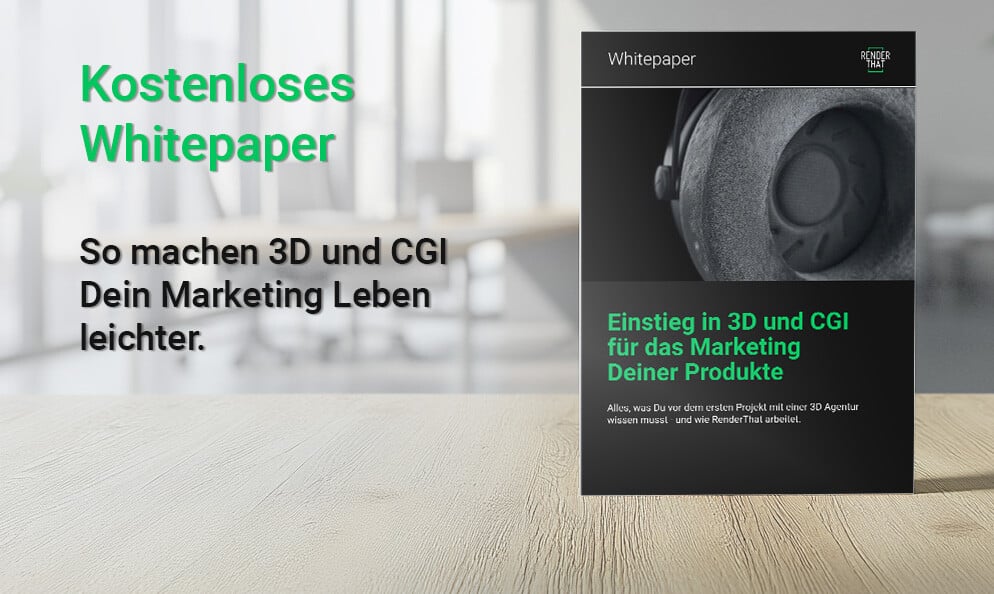CAD visualization and CAD rendering: Create photorealistic visualizations from CAD data

The visual presentation of products has become crucial, both in the B2C and B2B sectors. Especially since Corona, digital and immersive presentation is becoming increasingly important.
For product and marketing managers who want to present their physical products optimally, CAD visualization and CAD rendering offer powerful solutions. CAD data is the key to success.
This article provides a comprehensive introduction to the world of CAD visualization and CAD rendering and shows how companies can benefit from these technologies to achieve their marketing goals more easily and quickly.
What is CAD visualization and CAD rendering?
Definition and basics
CAD (computer-aided design) visualization and CAD rendering describe the process in which CAD data is converted into photorealistic images. These digital models of physical products are produced with high precision. CAD visualization includes the creation, editing and rendering of 3D models that are derived from CAD data.
With specialized software, designers can create complex 3D models that serve as the basis for photorealistic CAD renderings. These models can represent just about any physical product, from furniture to electronics to automobiles. 3D industrial visualizations are also based on this design data and offer an efficient solution for product marketing and sales.
Importance for product managers and marketing managers
For product and marketing managers, CAD visualization and CAD rendering are invaluable. They make it possible to present products realistically even before they physically exist. Photorealistic visualizations and CAD renderings help to convince potential customers and influence their buying decisions. They provide a precise idea of what a product will look like in reality, which reduces misunderstandings and bad purchases.
The process: From CAD data to photorealistic visualizations and CAD renderings
Step 1: Convert CAD data into 3D models
The first step in the process of CAD visualization and CAD rendering is to convert CAD data into 3D models. This data comes from CAD software, which is used to design and develop products. Precise work is required to ensure that the 3D model correctly reproduces all details of the original design.
Step 2: Optimize 3D models
After creating the 3D model, optimization follows. This includes texturing, lighting, and material properties to make the 3D model as realistic as possible and accurately represent all aspects of the product.
Step 3: Use shading to represent surfaces
Shading is a crucial step in CAD rendering, which makes the surfaces of the 3D models appear detailed and realistic. Various shading techniques faithfully represent the surface finish, such as shiny, matt, rough or smooth.
Step 4: Showcase the product (setting)
The setting, i.e. placing the 3D model in a suitable virtual environment, is important for the effect of the visualization. The product is presented in a context that highlights its functions and aesthetic properties.
Step 5: Set the right light
Lighting is an essential factor for the realism and visual quality of CAD visualizations and CAD renderings. Correct light placement, intensity, and direction create depth and dimension, essential for photorealistic presentations.
Step 6: Rendering: Have the “digital photo” developed
Rendering is the process of turning the 3D model into a finished image or animation. All specified elements such as geometry, textures, shading, setting and lighting are taken into account to create a photorealistic image.
Step 7: Delivery of final content formats
The last step is to export the rendered images and animations in the desired formats. These formats are optimized for use in online shops, catalogs, social media or other marketing channels. A professional presentation is crucial for the success of marketing campaigns.
Applications and benefits of CAD visualization and CAD rendering
Furniture visualization from CAD data
An outstanding example of the use of CAD visualization and CAD rendering is the furniture industry. Companies can present their furniture as photorealistic images as early as the design phase. These visualizations give potential customers the opportunity to view products in different environments and from different angles. For more information on the basics and trends of 3D visualization for furniture, please see our detailed blog post. Also for Interior visualizations for bathrooms 3D rendering based on CAD data is very popular.
Increasing marketing efficiency
Photorealistic visualizations and CAD renderings can significantly increase marketing efficiency. High-quality images result in higher customer loyalty and better conversion rates. In addition, these visualizations can be used for AR and VR applications to create immersive shopping experiences. Tips and solutions for using AR in the furniture business can be found in our Guide to augmented reality for furniture companies.
Cost savings and time savings
The use of CAD visualizations and CAD renderings can lead to significant cost savings and time savings. Traditional photo shoots are time-consuming and expensive, particularly with different product variants. Digital visualizations drastically reduce these costs and enable rapid adjustments. Learn more about costs and prices for 3D visualizations can be found in our Blog post about this topic.
Make yours Product digitization more efficient
We help companies digitize product portfolios with hundreds of items. Our workflows are tailored to your company and ensure maximum output with minimal effort.









